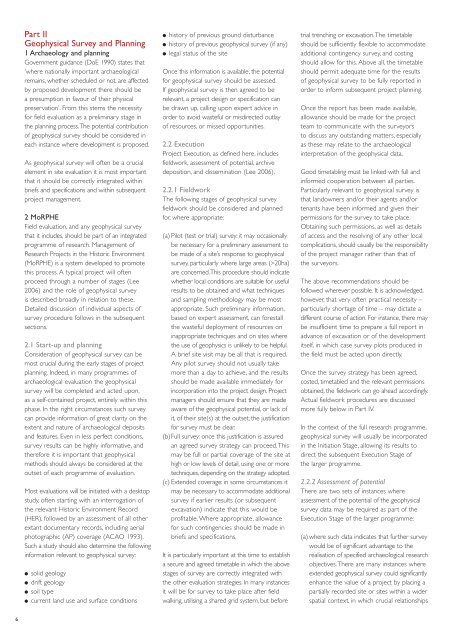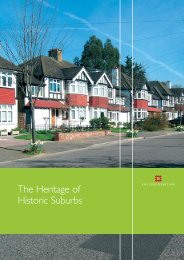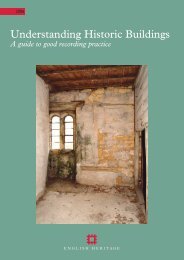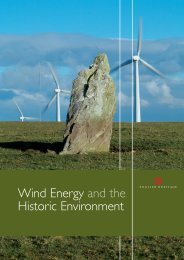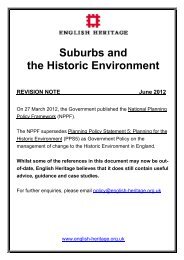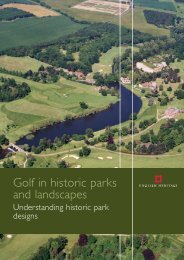Geophysical Survey in Archaeological Field Evaluation - HELM
Geophysical Survey in Archaeological Field Evaluation - HELM
Geophysical Survey in Archaeological Field Evaluation - HELM
Create successful ePaper yourself
Turn your PDF publications into a flip-book with our unique Google optimized e-Paper software.
6<br />
Part II<br />
<strong>Geophysical</strong> <strong>Survey</strong> and Plann<strong>in</strong>g<br />
1 Archaeology and plann<strong>in</strong>g<br />
Government guidance (DoE 1990) states that<br />
‘where nationally important archaeological<br />
rema<strong>in</strong>s, whether scheduled or not, are affected<br />
by proposed development there should be<br />
a presumption <strong>in</strong> favour of their physical<br />
preservation’. From this stems the necessity<br />
for field evaluation as a prelim<strong>in</strong>ary stage <strong>in</strong><br />
the plann<strong>in</strong>g process. The potential contribution<br />
of geophysical survey should be considered <strong>in</strong><br />
each <strong>in</strong>stance where development is proposed.<br />
As geophysical survey will often be a crucial<br />
element <strong>in</strong> site evaluation it is most important<br />
that it should be correctly <strong>in</strong>tegrated with<strong>in</strong><br />
briefs and specifications and with<strong>in</strong> subsequent<br />
project management.<br />
2 MoRPHE<br />
<strong>Field</strong> evaluation, and any geophysical survey<br />
that it <strong>in</strong>cludes, should be part of an <strong>in</strong>tegrated<br />
programme of research. Management of<br />
Research Projects <strong>in</strong> the Historic Environment<br />
(MoRPHE) is a system developed to promote<br />
this process. A typical project will often<br />
proceed through a number of stages (Lee<br />
2006) and the role of geophysical survey<br />
is described broadly <strong>in</strong> relation to these.<br />
Detailed discussion of <strong>in</strong>dividual aspects of<br />
survey procedure follows <strong>in</strong> the subsequent<br />
sections.<br />
2.1 Start-up and plann<strong>in</strong>g<br />
Consideration of geophysical survey can be<br />
most crucial dur<strong>in</strong>g the early stages of project<br />
plann<strong>in</strong>g. Indeed, <strong>in</strong> many programmes of<br />
archaeological evaluation the geophysical<br />
survey will be completed and acted upon,<br />
as a self-conta<strong>in</strong>ed project, entirely with<strong>in</strong> this<br />
phase. In the right circumstances such survey<br />
can provide <strong>in</strong>formation of great clarity on the<br />
extent and nature of archaeological deposits<br />
and features. Even <strong>in</strong> less perfect conditions,<br />
survey results can be highly <strong>in</strong>formative, and<br />
therefore it is important that geophysical<br />
methods should always be considered at the<br />
outset of each programme of evaluation.<br />
Most evaluations will be <strong>in</strong>itiated with a desktop<br />
study, often start<strong>in</strong>g with an <strong>in</strong>terrogation of<br />
the relevant Historic Environment Record<br />
(HER), followed by an assessment of all other<br />
extant documentary records, <strong>in</strong>clud<strong>in</strong>g aerial<br />
photographic (AP) coverage (ACAO 1993).<br />
Such a study should also determ<strong>in</strong>e the follow<strong>in</strong>g<br />
<strong>in</strong>formation relevant to geophysical survey:<br />
● solid geology<br />
● drift geology<br />
● soil type<br />
● current land use and surface conditions<br />
● history of previous ground disturbance<br />
● history of previous geophysical survey (if any)<br />
● legal status of the site<br />
Once this <strong>in</strong>formation is available, the potential<br />
for geophysical survey should be assessed.<br />
If geophysical survey is then agreed to be<br />
relevant, a project design or specification can<br />
be drawn up, call<strong>in</strong>g upon expert advice <strong>in</strong><br />
order to avoid wasteful or misdirected outlay<br />
of resources, or missed opportunities.<br />
2.2 Execution<br />
Project Execution, as def<strong>in</strong>ed here, <strong>in</strong>cludes<br />
fieldwork, assessment of potential, archive<br />
deposition, and dissem<strong>in</strong>ation (Lee 2006).<br />
2.2.1 <strong>Field</strong>work<br />
The follow<strong>in</strong>g stages of geophysical survey<br />
fieldwork should be considered and planned<br />
for, where appropriate:<br />
(a) Pilot (test or trial) survey: it may occasionally<br />
be necessary for a prelim<strong>in</strong>ary assessment to<br />
be made of a site’s response to geophysical<br />
survey, particularly where large areas (>20ha)<br />
are concerned. This procedure should <strong>in</strong>dicate<br />
whether local conditions are suitable for useful<br />
results to be obta<strong>in</strong>ed and what techniques<br />
and sampl<strong>in</strong>g methodology may be most<br />
appropriate. Such prelim<strong>in</strong>ary <strong>in</strong>formation,<br />
based on expert assessment, can forestall<br />
the wasteful deployment of resources on<br />
<strong>in</strong>appropriate techniques and on sites where<br />
the use of geophysics is unlikely to be helpful.<br />
A brief site visit may be all that is required.<br />
Any pilot survey should not usually take<br />
more than a day to achieve, and the results<br />
should be made available immediately for<br />
<strong>in</strong>corporation <strong>in</strong>to the project design. Project<br />
managers should ensure that they are made<br />
aware of the geophysical potential, or lack of<br />
it, of their site(s) at the outset; the justification<br />
for survey must be clear.<br />
(b)Full survey: once this justification is assured<br />
an agreed survey strategy can proceed. This<br />
may be full or partial coverage of the site at<br />
high or low levels of detail, us<strong>in</strong>g one or more<br />
techniques, depend<strong>in</strong>g on the strategy adopted.<br />
(c) Extended coverage: <strong>in</strong> some circumstances it<br />
may be necessary to accommodate additional<br />
survey if earlier results (or subsequent<br />
excavation) <strong>in</strong>dicate that this would be<br />
profitable. Where appropriate, allowance<br />
for such cont<strong>in</strong>gencies should be made <strong>in</strong><br />
briefs and specifications.<br />
It is particularly important at this time to establish<br />
a secure and agreed timetable <strong>in</strong> which the above<br />
stages of survey are correctly <strong>in</strong>tegrated with<br />
the other evaluation strategies. In many <strong>in</strong>stances<br />
it will be for survey to take place after field<br />
walk<strong>in</strong>g, utilis<strong>in</strong>g a shared grid system, but before<br />
trial trench<strong>in</strong>g or excavation.The timetable<br />
should be sufficiently flexible to accommodate<br />
additional cont<strong>in</strong>gency survey, and cost<strong>in</strong>g<br />
should allow for this. Above all, the timetable<br />
should permit adequate time for the results<br />
of geophysical survey to be fully reported <strong>in</strong><br />
order to <strong>in</strong>form subsequent project plann<strong>in</strong>g.<br />
Once the report has been made available,<br />
allowance should be made for the project<br />
team to communicate with the surveyors<br />
to discuss any outstand<strong>in</strong>g matters, especially<br />
as these may relate to the archaeological<br />
<strong>in</strong>terpretation of the geophysical data.<br />
Good timetabl<strong>in</strong>g must be l<strong>in</strong>ked with full and<br />
<strong>in</strong>formed cooperation between all parties.<br />
Particularly relevant to geophysical survey is<br />
that landowners and/or their agents and/or<br />
tenants have been <strong>in</strong>formed and given their<br />
permissions for the survey to take place.<br />
Obta<strong>in</strong><strong>in</strong>g such permissions, as well as details<br />
of access and the resolv<strong>in</strong>g of any other local<br />
complications, should usually be the responsibility<br />
of the project manager rather than that of<br />
the surveyors.<br />
The above recommendations should be<br />
followed wherever possible. It is acknowledged,<br />
however, that very often practical necessity –<br />
particularly shortage of time – may dictate a<br />
different course of action. For <strong>in</strong>stance, there may<br />
be <strong>in</strong>sufficient time to prepare a full report <strong>in</strong><br />
advance of excavation or of the development<br />
itself, <strong>in</strong> which case survey plots produced <strong>in</strong><br />
the field must be acted upon directly.<br />
Once the survey strategy has been agreed,<br />
costed, timetabled and the relevant permissions<br />
obta<strong>in</strong>ed, the fieldwork can go ahead accord<strong>in</strong>gly.<br />
Actual fieldwork procedures are discussed<br />
more fully below <strong>in</strong> Part IV.<br />
In the context of the full research programme,<br />
geophysical survey will usually be <strong>in</strong>corporated<br />
<strong>in</strong> the Initiation Stage, allow<strong>in</strong>g its results to<br />
direct the subsequent Execution Stage of<br />
the larger programme.<br />
2.2.2 Assessment of potential<br />
There are two sets of <strong>in</strong>stances where<br />
assessment of the potential of the geophysical<br />
survey data may be required as part of the<br />
Execution Stage of the larger programme:<br />
(a) where such data <strong>in</strong>dicates that further survey<br />
would be of significant advantage to the<br />
realisation of specified archaeological research<br />
objectives. There are many <strong>in</strong>stances where<br />
extended geophysical survey could significantly<br />
enhance the value of a project by plac<strong>in</strong>g a<br />
partially recorded site or sites with<strong>in</strong> a wider<br />
spatial context, <strong>in</strong> which crucial relationships


